June 20- July 5, 2022
If your language was blinking toward extinction but you could choose one word of your heritage to be carried forward, what would it be?
Mahsi Cho!
[Thank you!]
I heard it, read it, and was gently taught it over and over again as we moved through Dene and Slave lands. It prompted me to reflect on the question above and I thought it telling of the culture of folks among whom we moved that they would choose to emphasize gratitude.
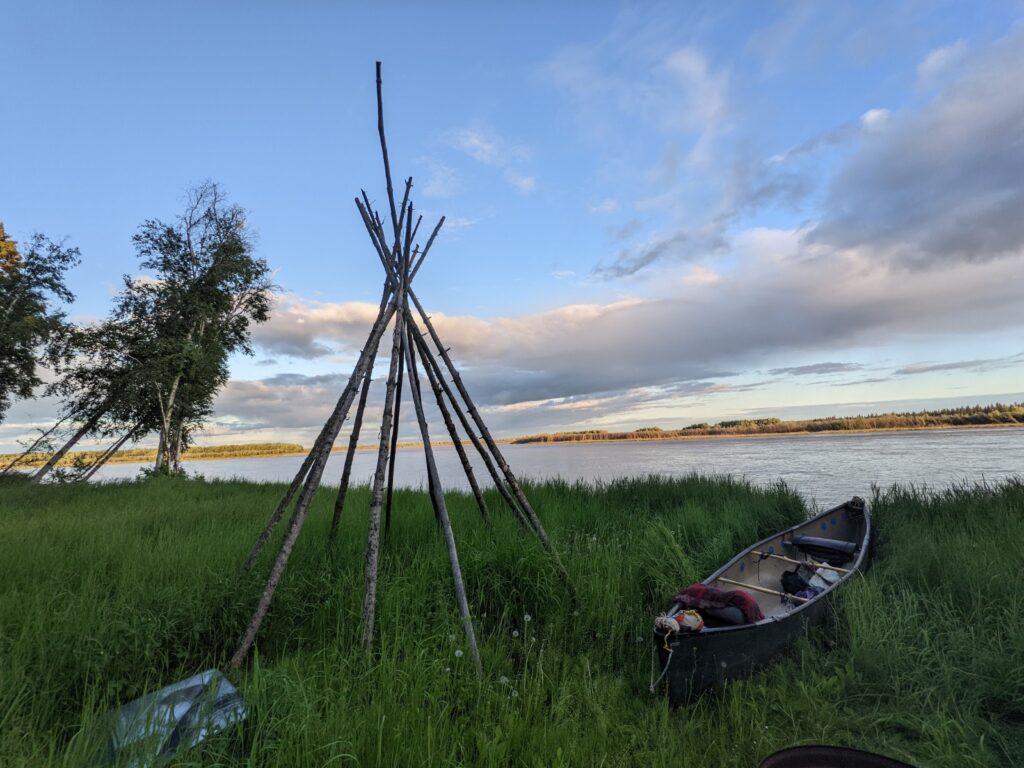
Paddling away from Fort Chipewyan, we began down the braids of the Slave River (named after the Slavey First Nations indigenous peoples). The locals had advised us well as to which channels to follow and where we’d have to portage around a weir in the first few days. We had also stopped by the Parks Canada office to get permits as we paddled along Wood Buffalo, Canada’s largest National Park. (The locals pointed out that if we camped on river right [east bank] we could avoid the matter altogether.)
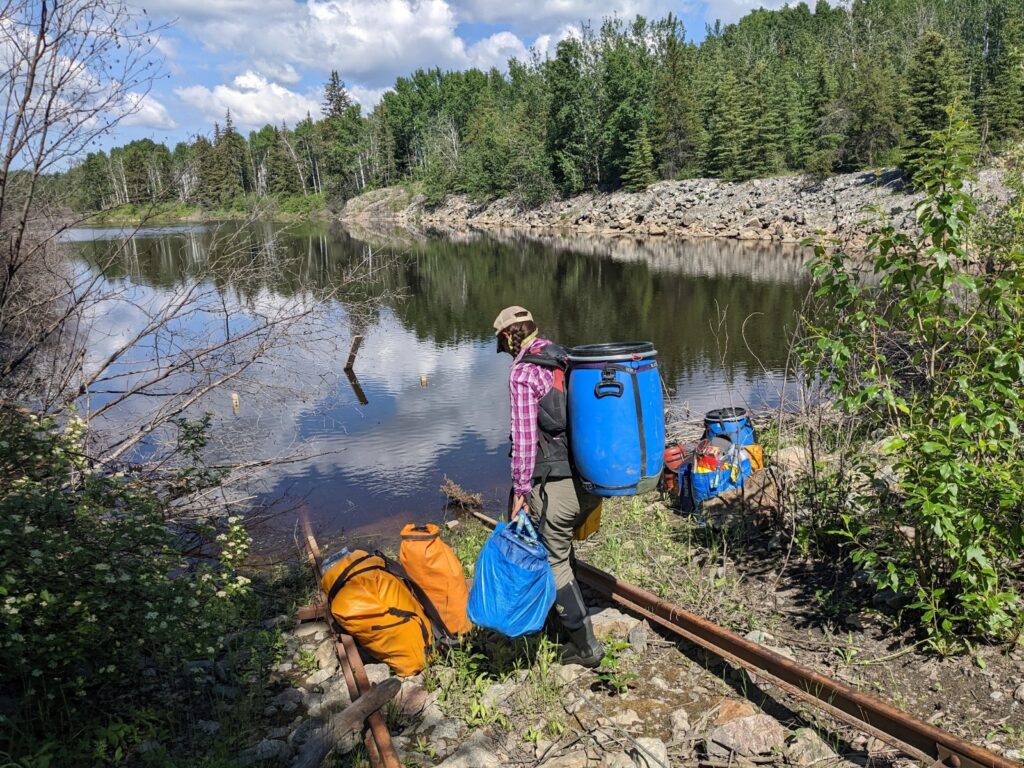
We were curious to get to know the character of this next river. Enthralled by the rocks after so much delta and tussock we paddled happily through days of milky river solitude framed by paddling past settlements and forts. We had another 4 day stretch of not another human soul in sight. Settling into our rhythms we began listening to books on tape for a few hours a day.
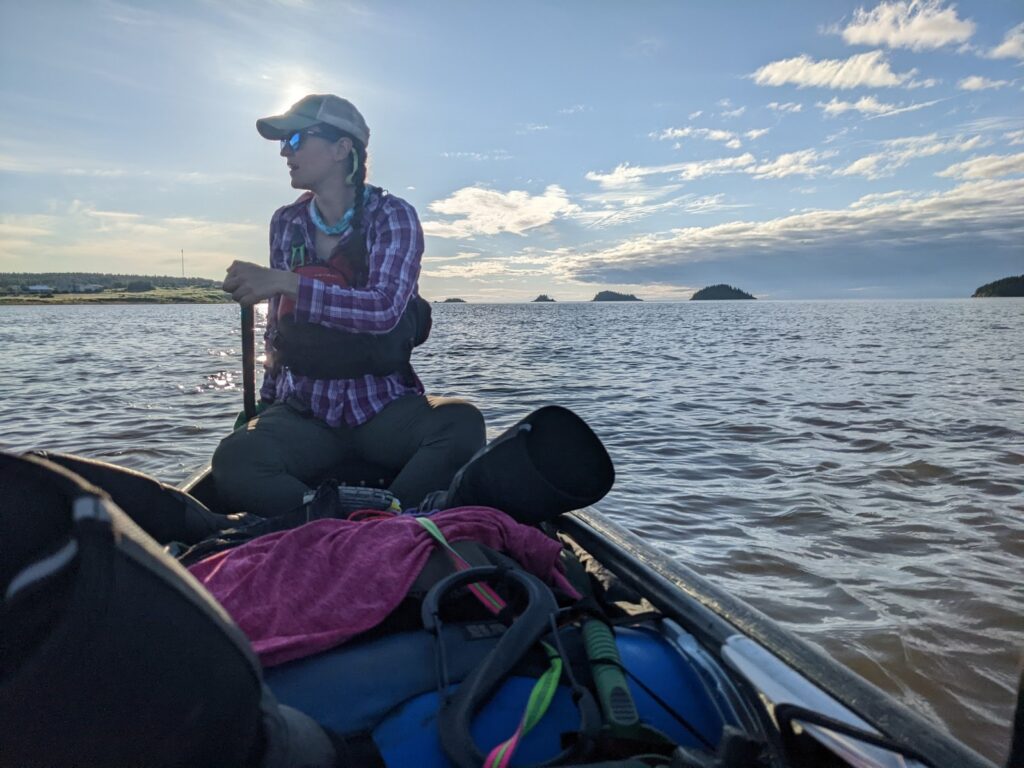
Here also, the insects found us. First came a species of biting fly which we only ever heard referred to as ‘Bulldogs.’ Dense, tenacious, little beasts. They were soon joined by another, slimmer, biting fly which I called ‘the Lazarus Bug’. The milieu was rounded out when the mosquitoes joined in through the deltas and swampier areas.
With reliable company like this we quickly developed the routine of donning bug jackets and headnets before steering the boat toward shore (when we stayed out on the water they weren’t much of a nuisance) and then our first priorities were erecting the shelters. We had the tent as well as a cooking shelter, which was a sanity saver! We had been guided toward a NoBugZone CT 11, which allowed space for our cooking gear and both of us to rest and wiggle about comfortably.
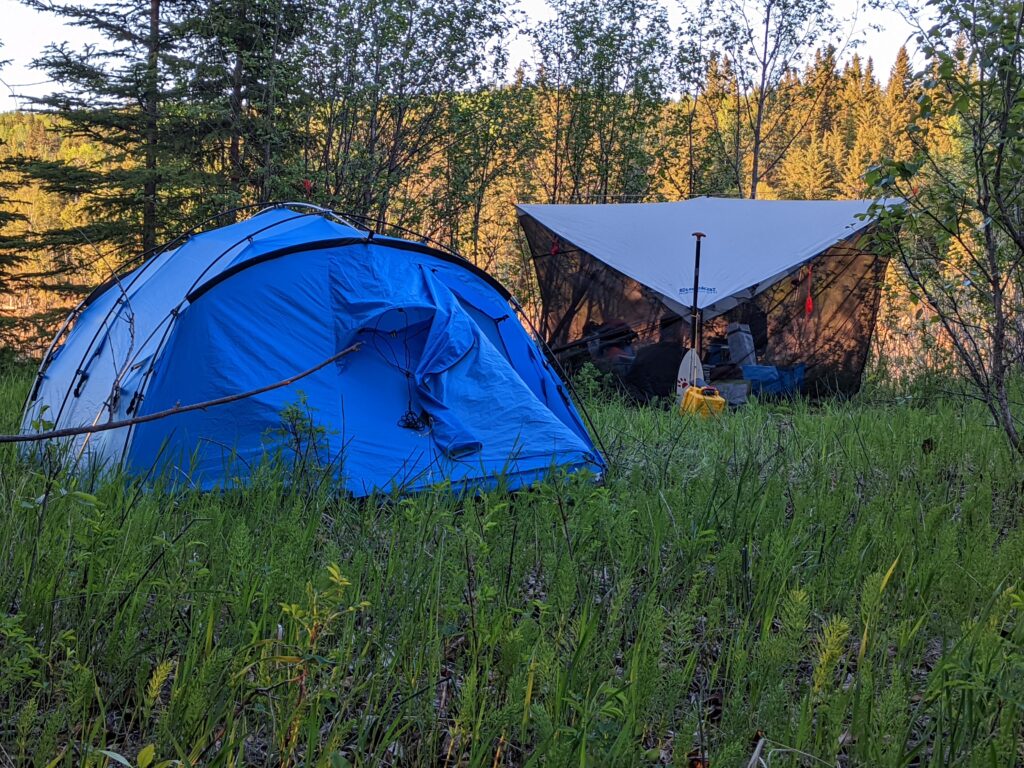
Midway down Slave River we arrived to Fitzgerald. Once a central community, in this lifetime by government plan, it was picked up and most folks relocated to Fort Smith just across “the border” into the North West Territories.
Willard put it simply enough, “They moved our families from here to Fort Smith. Don’t know why.” his eyes followed the water. He had come down with his dog to watch the water, same as he does most evenings since retiring. He told us about summer temperatures of 40+ C for which there was no reprieve. He spoke with pride of his sobriety and how pursuing martial arts helped him hold to that. He shared tales of the Deh Nacho, the giant people, who live in burrows deep in the boreal.
The trend in the stories some folks shared, of being made to pick up and move, made perfect sense why the likes of the Other People (Sasquatch and also the Little People) would choose to keep their homes hidden deep in the ground. The humans told it so gently, like Sharon who came to sit and chat with me outside of Anna’s Restaurant in Fort Smith. In 1976 her family had been moved from Reindeer Station to Inuvik. She didn’t complain, she simply framed it saying, “I still don’t know why they made us move. I liked it at Reindeer Station much better.”
We were always received kindly and treated generously. When we stopped through communities, folks of all ages trickled past with curiosity and offers of help. They almost always asked if we’d seen moose. Some were spiritual and suggested giving a gift of tobacco to the river. Others were pragmatic and saw more utility in smoking it themselves.
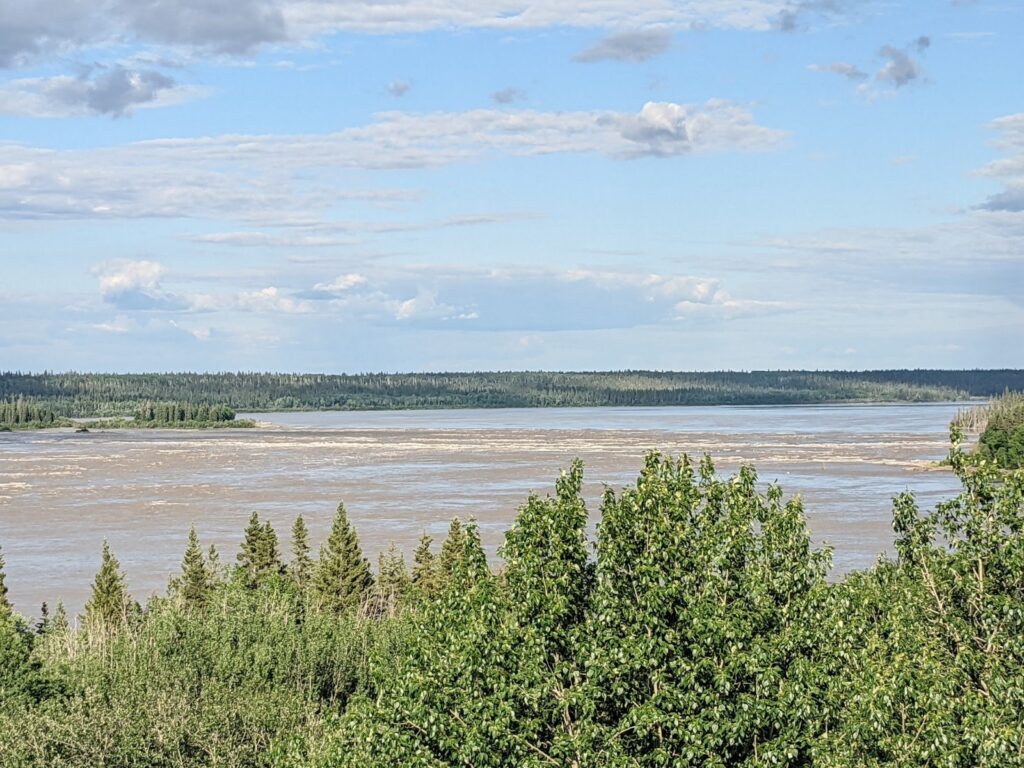
Between Fitzgerald and Fort Smith the river hosts a series of world famous rapids: Cassette, Pelican, Mountain-Portage, and Rapids of the Drowned. An annual Paddlefest gathers white water lovers to enjoy the fun but we intended to portage the 25 km stretch, though, were not quite sure how. As it turned out, we’d only just landed at the end of a 99 km day and began making dinner when a local came by in his truck and offered a lift the next morning.
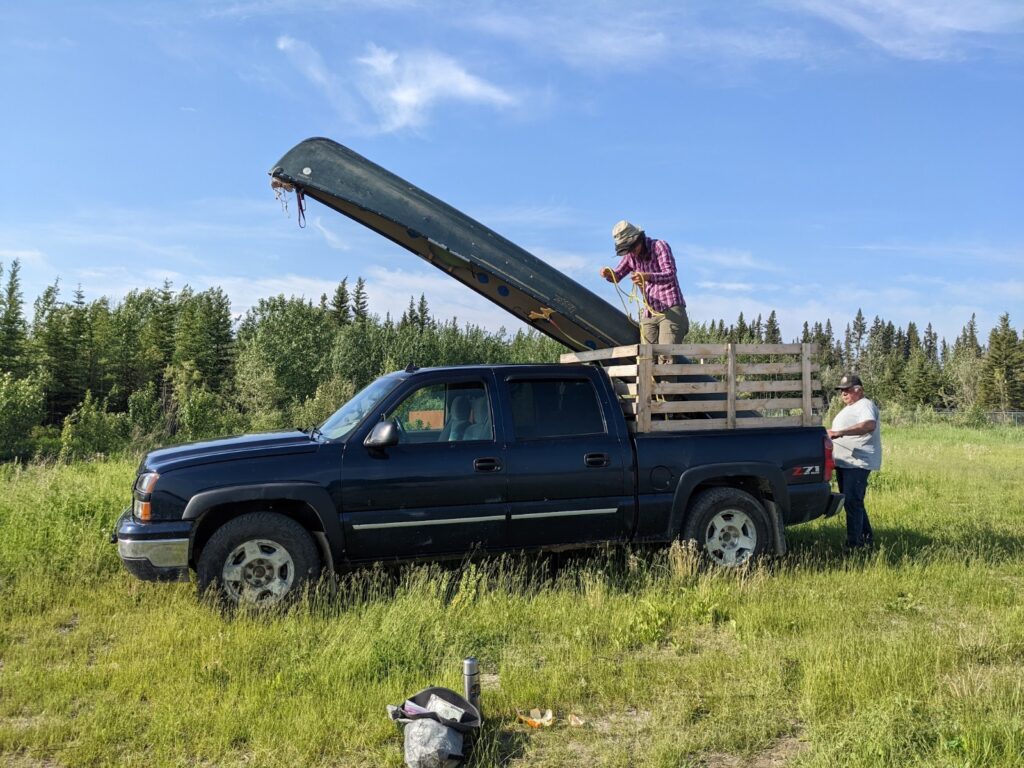
In these remote areas, in towns with roads which connect to nowhere in the summer, we noticed folks coming down to the river, seemingly just to watch the water. Around 8-10 pm the kids would come out to play and swim, parents taking turns, like the geese, watching over each others’ broods. This unhurried tradition at first struck me as curious but as I settled in to rhythm I began to appreciate a deeper quality of the communion transpiring.
While Neon took all of our gear and managed setting up at the campground in Fort Smith, I and my entourage of bulldogs were free to walk to Fort Smith. It felt good to stretch my legs and chat with the folks who stopped to check on me and tell stories of other paddlers they’d met.
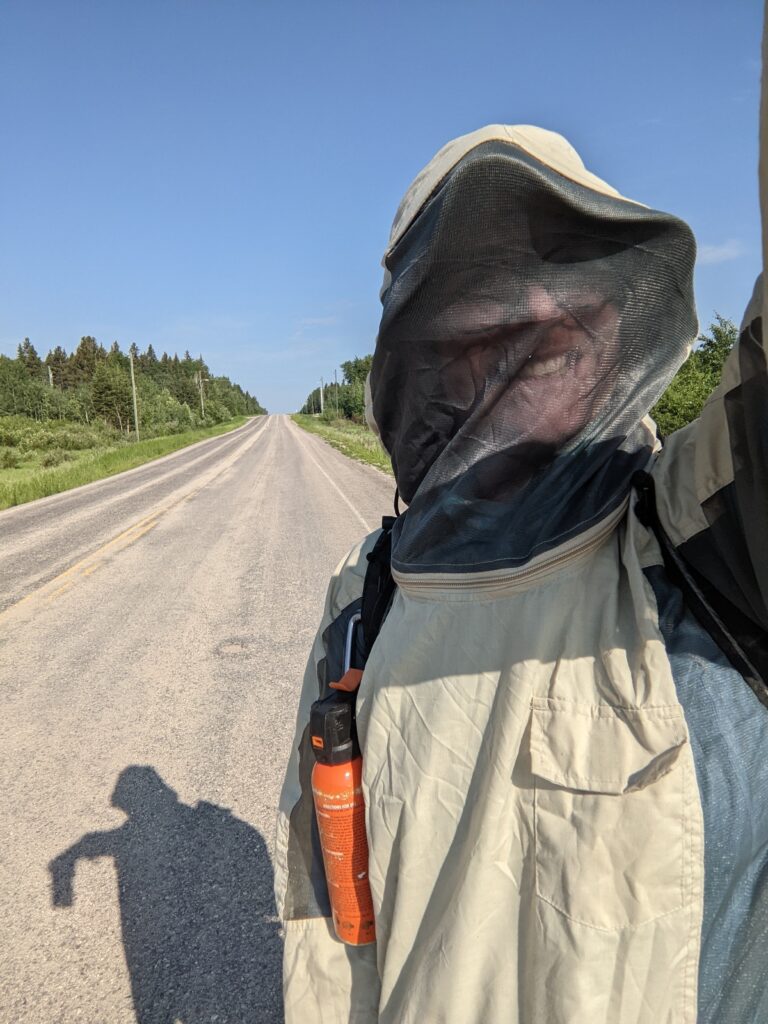
We had a precious short whirlwind of a time in Fort Smith, aided much by Lyn Elliot, an avid paddler who had done a long distance adventure which overlapped a good portion of ours.
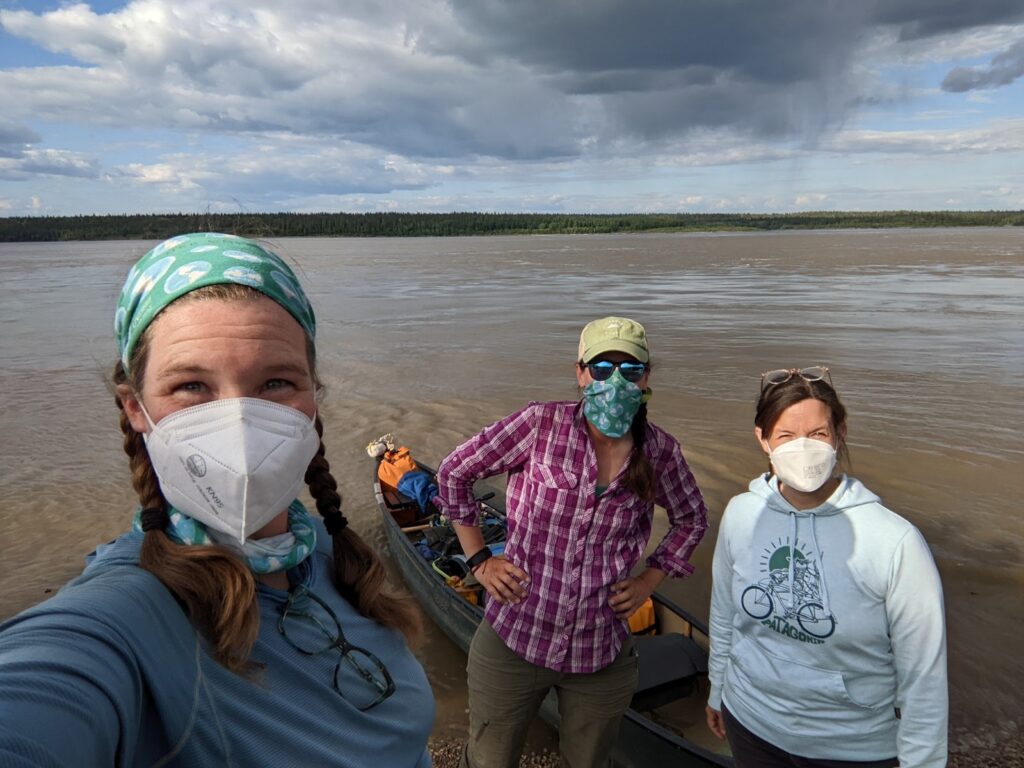
We also got to chat with Carla, who works for the CBC who came to visit us at camp that first evening. During our interview I mentioned how we’ve found humor to be a survival tool and she let that resonate and amplify on what I’ve seen of many of these folks, that humor is woven deeply and laughter rises from the trunk. “It’s how our people have survived horrors,” she said.
She told stories of her Granny, of her aspirations and dreams. She seemed particularly taken aback when I mentioned that a couple passing vehicles had been a little less than friendly and I was humbled the next day, while doing town chores, that a truck-load of local men going to work stopped in the middle of the road pronouncedly and laughing, to call out, “welcome to Fort Smith!”
She also conjured up a bushman for us to consult about the stretch ahead, as there were some confusing looking channels on the way out to Great Slave Lake. Terrance stopped by and told stories of the waters, of his ambition to one day motor all the way up to Inuvik, of his hunting escapades and showed us pictures of muskox, whom I long to meet. He also gave us warnings about the Great Slave Lake. How the waters can whip up quickly and of times that even in his motorboat he’d had to take shelter in the lee of islands.
We soon had our heads bowed together over the maps. He marked, quite precisely, where the various cabins and camps were ahead, naming each person who’d built them and extending invitations on their behalf for us to stay.
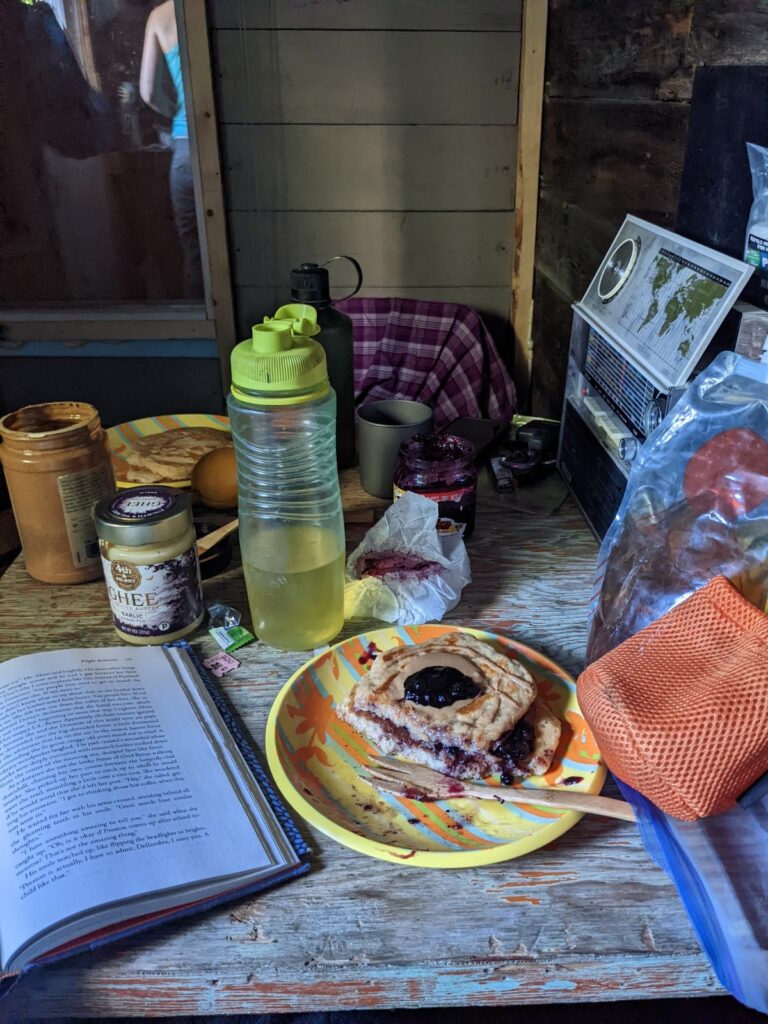
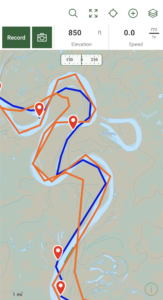
He pointed out one particular oxbow on the river which, while it would take over 12 kms of paddling, gained less than .5 km of northward progress. He seemed, almost apologetic, familiar with the frustration. Then he quipped, “but the river will have cut through soon.” By geologic time and indigenous memory standards, we were there a split second too soon to enjoy the shortcut. He pointed out another oxbow which had now been cut off from the rest of the river entirely, into its own lake.
I took this opportunity to ask if there is a particular way to convey gratitude. Whether we should be leaving gifts or donations when we crashed on folks’ land. He regarded me quizzically for a moment then replied, “just say thank you and mean it.”
With this beta, kindness, and care, we enjoyed a meal at Anna’s Kitchen and met up with Lyn, who gave us and our gear a lift to the put in below the rapids. The wind usually quieted down in the evenings and I was looking forward to an evening paddle. At the water’s edge we met two women in play boats well familiar with the area.
They urged us that if an elder offered a cup of tea, it is imperative to accept. It reminded me of the greasy mugs of chicha passed around after the communities had worked their fields in Peru. They also, quite blank, issued stern warnings about Great Slave Lake, saying, “white people are always coming up here and finding ways to die.” With these notices ringing in our ears, we paddled on.
The next stretch was peaceful. Just us, the ducks, biting flies, and ‘skeeters. The Neggel channel out to Great Slave Lake had been recently cleared of deadfall by local teams and we enjoyed the narrower passage, which afforded reprieve from the sun and wind.
On June 29th, we paddled out to Nagel Bay, just north of Mission Island and Fort Resolution. The next morning, paddling around the peninsula of Mission Island, we passed a beautifully maintained lakefront campground, RV, and cabins run by the Deninu Kue First Nation just across the bay from the community.
We landed on the white sands of the community beach, curious that there was a gazebo half in the water. We planned to rest for the day and strike out to that evening, hoping that night paddling would afford us the best chance of crossing the Great Slave Lake without winds.
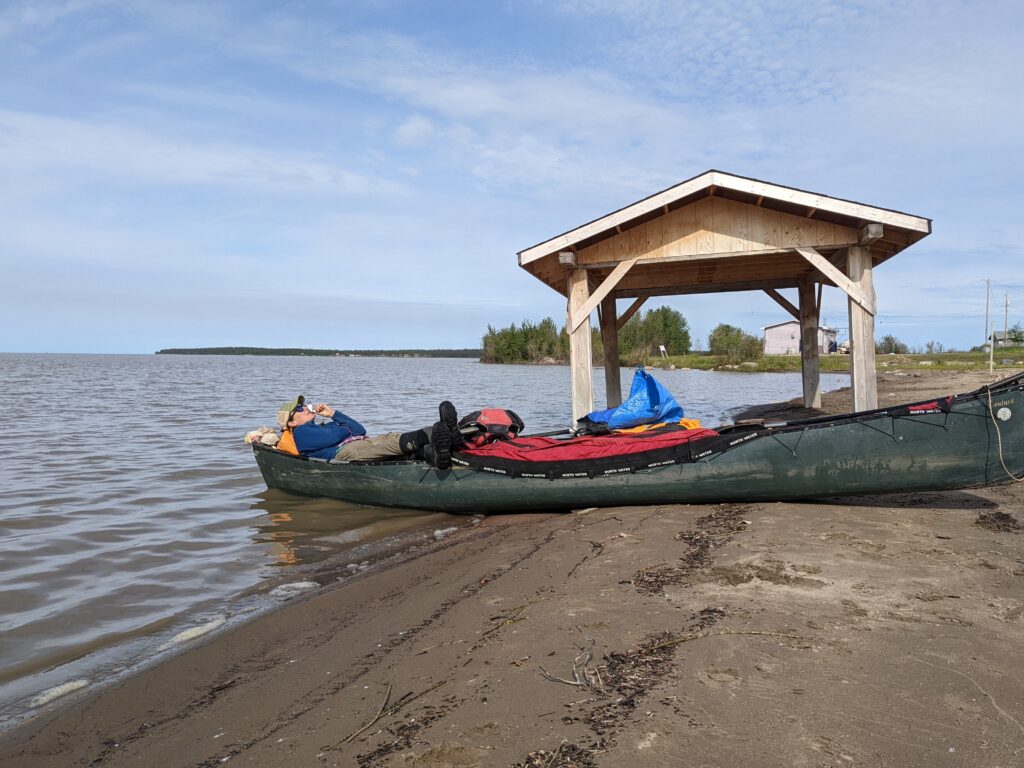
The community began to trickle past.
Lawrence appeared on his quad and explained the mystery of the half submerged gazebo. This beach used to extend over a hundred meters further out. They had built a boardwalk, sand volleyball, and the gazebo. Within years, the water had risen and swallowed much of it up. He offered to fill our water dromedaries and buzzed away. Returning, he presented them filled to the nozzle and refreshingly cold, having pulled water from his fridge. “We used to drink from the lake, but now with the mines…we can’t trust it.” his eyes drifted out across the watery expanses.
Around 8 pm a bunch of kids came down to the beach after a birthday party to swim and play. Brielle & Colleen among them had a lot of good questions and we played show and tell. Brielle assessed our paddles, “our blades are longer,” she surmised assuredly.
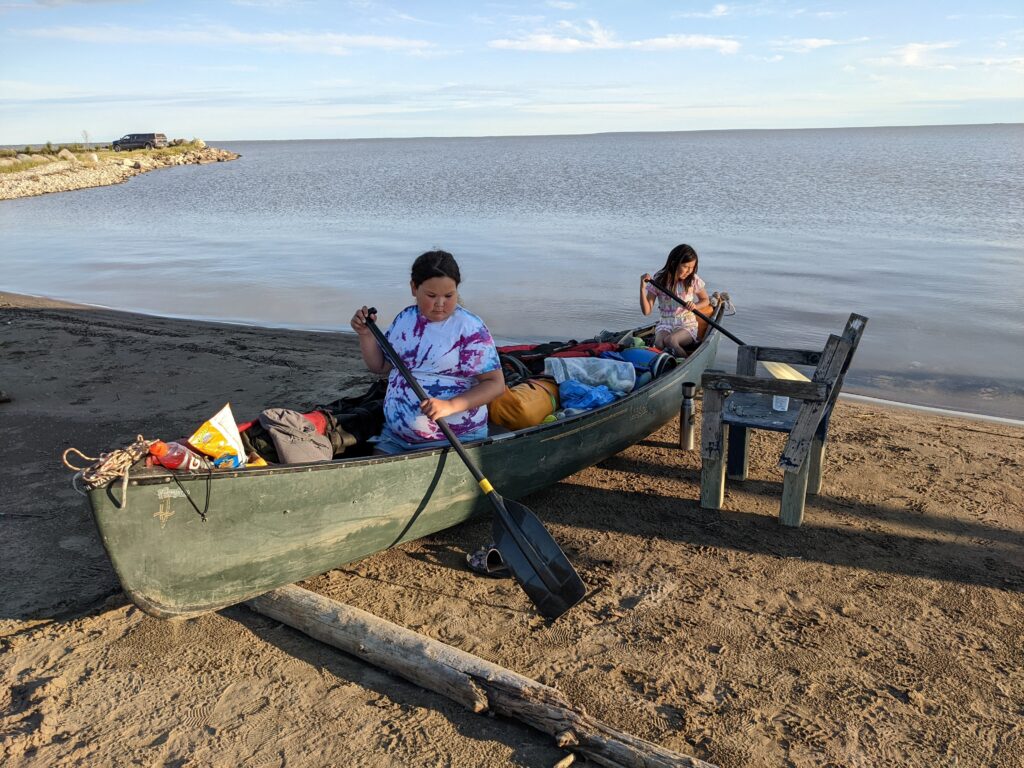 An elder named Lucy gave us a driving tour of Fort Res and spoke of faith, hair growth, and cancer. We stopped on the tour for her to give half of her remaining candy bar to one of her grandkids. She reassured us that our kit on the beach was fine, she had sent one of her granddaughters to keep an eye on it while we were gone. After our tour she dropped us off and blessed us each with a rosary.
An elder named Lucy gave us a driving tour of Fort Res and spoke of faith, hair growth, and cancer. We stopped on the tour for her to give half of her remaining candy bar to one of her grandkids. She reassured us that our kit on the beach was fine, she had sent one of her granddaughters to keep an eye on it while we were gone. After our tour she dropped us off and blessed us each with a rosary.
While the rest of the kids had taken off, sure enough, a young woman sat on a picnic table near our boat with one of her friends and their phones. She looked up as her grandma waved. I had bought myself 3 candy bars for the stretch to Hay River of which I offered each of the girls their pick.
We were soon loaded up and began wrenching our boat into the water, when out of nowhere, two older women, Brielle, and Colleen appeared and lay hands on the gunwales and with laughter and heave ho, they sent us on our way. Together, it was much easier work and we paddled off with the midnight sun reflecting in the tears shimmering in my eyes.
This was the peak of summer and we called it “sun set rise.” The sun dipped, the skies greyed, and then began to dawn again. We passed Little Buffalo River with water Lawrence had told us was the same color as that in the Bahamas. He had chuckled at his own joke and we paddled over inky blackness and cold dawn fog.
Winds coming out of the north have made this southern shore very shallow and filled the many scooped bays with layers upon layers of stripped logs, clacking and crushing against each other. Others had been driven into the lake bed and protruded just above the water (sometimes) like spikes. Neon worked hard to hold our direction but when the winds rose from the broadside, every moment was a struggle. Even getting close enough in to shore to consider whether we could land was a risk and it was rare to find solid ground.
On the second sketchily windy morning, we tucked in behind Paulette Island and were surprised to find a fish camp with a dirt road out to Highway 6. In need of rest, we made camp and anxiously watched the inReach Dark Sky weather reports, hoping to see winds coming from any direction other than north and anything under 17 kph.
We waited one day and then two. On the 3rd day some elders came down, scouting for berries and shared stories. By the 4th day, we began the conversation neither of us wanted to have.
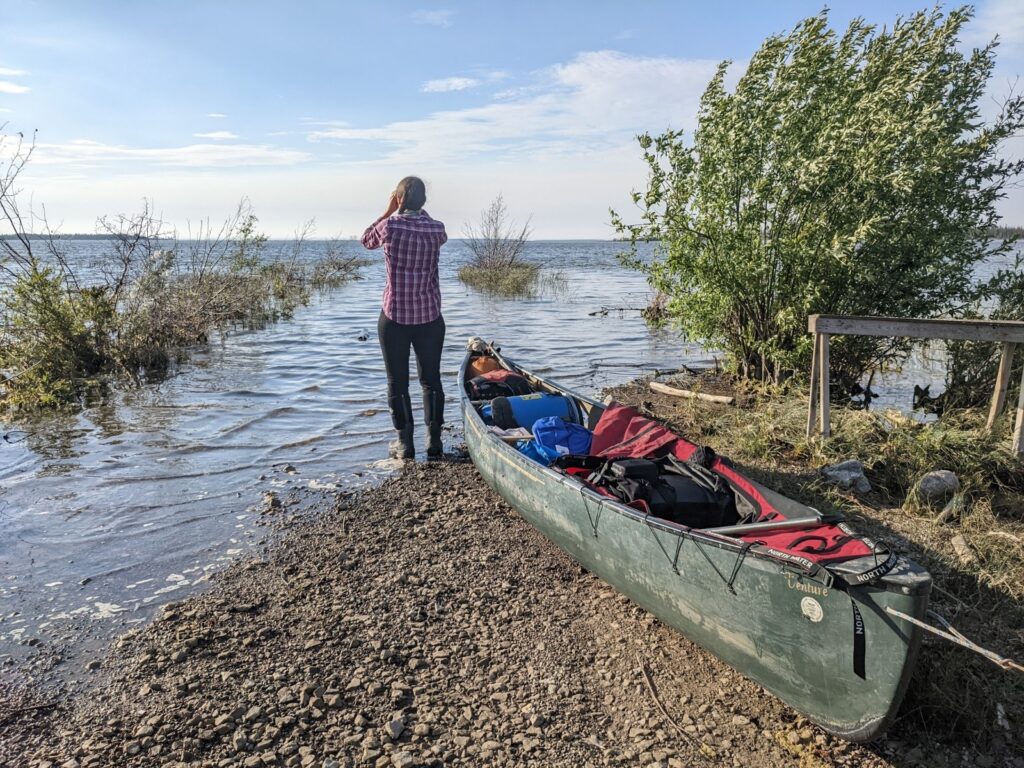
The stretch ahead was where a young man, one of the last to paddle through here, had drowned. We’d not expected to encounter this road and being given this reprieve and option was beginning to seem like a sign and gift as the forecast was not to our favor.
We alternated wandering out to the water, scouring with the binoculars and still seeing white out past the break of the island. I gave salty little tears to the water lapping around my feet. Begged, gambled, raged, rationalized, and finally, accepted. Wrote a plea on the tyvek footprint of the tent and headed out to the road to hitch a ride into Hay River.
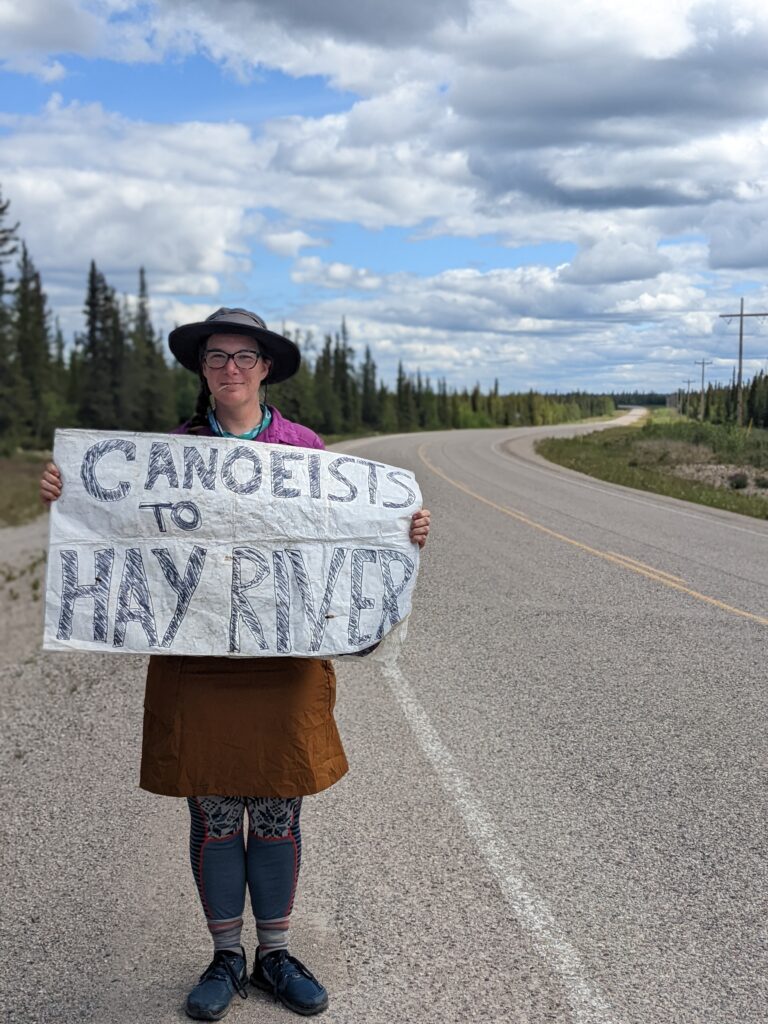






Comments (3)
Oh, my goodness. Thank you for the gift of vicarious experience. This sentence is award-winning— “By geologic time and indigenous memory standards, we were there a split second too soon to enjoy the shortcut.”—as an example of keenly aware, deep-map traveling. Mahsi Cho!
This is super helpful feedback as I was trying to decide which excerpt to pull for social media sharing!
Pingback: Canoeing the Deh Cho [Mackenzie River] Pt. IV: the Delta – Her Odyssey